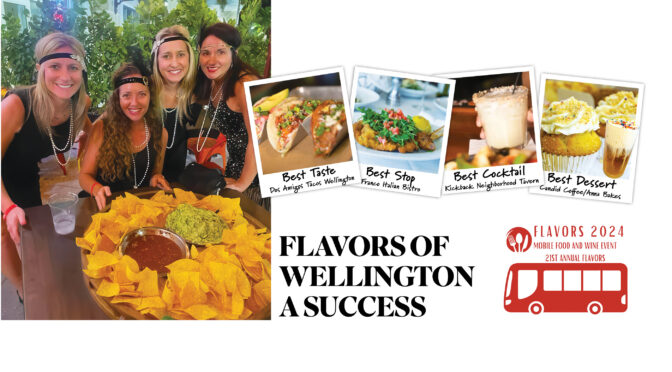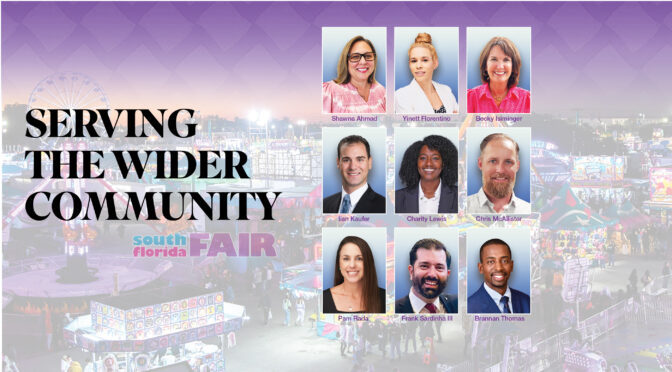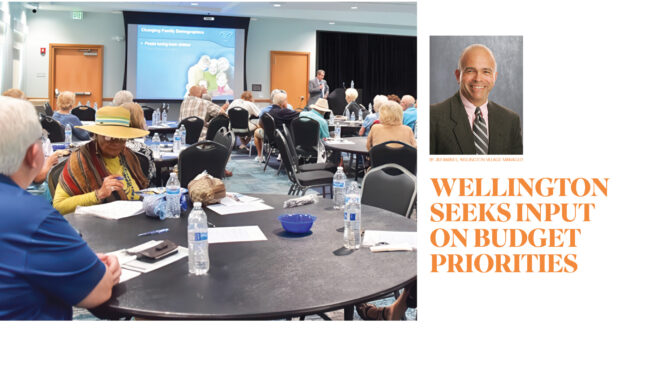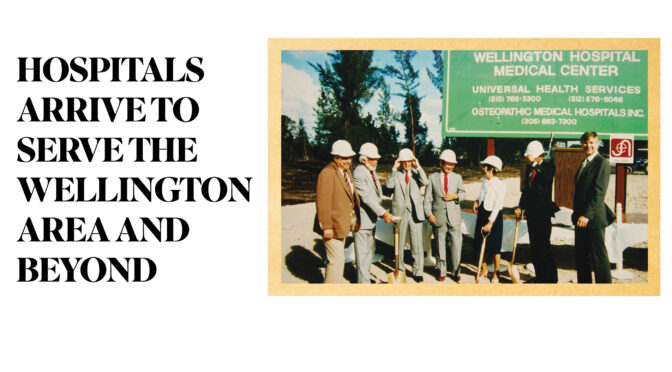Hospitals Arrive To Serve The Wellington Area And Beyond
The Two Major Medical Hubs Serving The Greater Wellington Community Both Date Back To 1986
By Joshua Manning
Wellington Regional Medical Center and HCA Florida Palms West Hospital started small in the 1980s and grew to become beacons of healthcare serving patients across central Palm Beach County and beyond. This month we go back in time to the early 1980s, where medical procedures meant a long trek east for Wellington residents.
It was a banner year for local healthcare in 1986, when, after years of planning, two hospitals opened to serve the Wellington area.
Originally small outposts on large tracts of land, Wellington Regional Medical Center and HCA Florida Palms West Hospital have grown exponentially over the past four decades, now offering the most state-of-the-art care available to residents who once had to trek 40 minutes or more to the coast for even the most basic medical procedures.
However, back in the early years of the western communities, that was exactly what regional officials wanted. These local hospitals, now anchors in the Wellington economy, had to fight state regulators and county officials for years before being awarded the necessary approvals to build.
The national companies that built the two hospitals in the Wellington area still operate them today. In the case of WRMC, that would be Pennsylvania-based Universal Health Services (UHS), and in the case of Palms West Hospital, it’s Tennessee-based Hospital Corporation of America, now HCA Healthcare.
WRMC has provided a wide array of healthcare services to the residents of central Palm Beach County since 1986.
It started with the vision of UHS founder and Executive Chairman Alan B. Miller, said Ben Boynton, who served for years as a hospital board member.
“He chose that parcel of land based on the growth of what Wellington was envisioned to be,” Boynton said of Miller. “There were a lot of people who doubted his foresight on that property, but he pushed through as a visionary.”
Miller recalled observing the development of Wellington in the 1970s, noting that the population was growing rapidly.
“By 1986, three local doctors decided that the growing communities on the western side of the county needed a community hospital,” Miller recalled. “The doctors entered into negotiations with a number of major corporations but selected UHS to turn their vision into a reality. When UHS opened Wellington Regional in 1986, the population was growing at a rate of 50 percent.”
Dr. Jeffrey Bishop was the first physician working at the new hospital.
“I watched it being built. I was doing my internship at the old Humana Hospital,” Bishop recalled. “The doctors who opened that hospital — Dr. Harold Kirsh, Dr. Michael Longo and Dr. Albert LaTorra — recruited me. These guys were all DOs, and they wanted to open up an osteopathic hospital in the western communities.”
That dream was accomplished working with UHS. The company’s representative overseeing the project was Richard Wright. “They recruited me to open a practice in the western communities,” Bishop said. “My first office was on the third floor of the hospital before the medical buildings were built.”
Miller noted that the doctors — Longo, LaTorra and Kirsh — owned the certificate of need (CON) required to build the hospital and worked with UHS to develop the project, while developer Bruce Rendina helped the company acquire the land.
“We are always evaluating the opportunities within key markets across the U.S. to determine where there is healthcare need that we could address,” Miller said. “In the case of Palm Beach County, we had been monitoring the possibility of acquiring land in that region for several years. When the chance to acquire the land presented itself, we took swift action to seize the opportunity.”
Miller noted that in 1986, both hospitals were under construction at the same time.
“Community members expressed questions and were not certain that two hospitals were needed,” he recalled. “However, we had data indicating that the community would grow and that we would meet the need of future growth.”
In the early years, the main issue that Bishop recalled was keeping the place full. “There were days where patients from my practice were the only ones in the hospital,” he said, adding that competition was fierce with Palms West Hospital, which had already opened. “The big concern was if there’s a need for two hospitals in the western communities, but obviously, some people had good foresight.”
Bishop recalled the equestrian-themed décor and high-end caterer that ran the food service during the early years. “People came in off the streets to eat there,” he said.
He is very proud of how WRMC has grown over the past four decades.
“It has developed into a full-fledged community hospital that serves the community in a great manner,” said Bishop, who served on the hospital’s board for 25 years, including five as chair. “It has all kinds of specialty services, such as the NICU and a huge emergency department. It’s a certified stroke center, does cardiac catheterization and robotic services. They do the full gamut of what a hospital does now.”
Bishop also served as chief medical officer and program director for the hospital’s family medicine residency program, among other roles. He is also proud of his work developing the surgery and medical peer review committees.
Kevin DiLallo served as CEO of the hospital during its largest expansion years, from 1997 to 2010.
“I was there during the largest growth in the hospital’s history,” recalled DiLallo, who is now vice president of development for UHS and overseeing the construction of a new hospital for the company in Palm Beach Gardens. “We built medical offices one, two, three and four. We put the front tower on. We built the new emergency room. We built the Level III NICU, which is now named after me. There was massive growth during those years.”
During his time at the hospital, DiLallo saw a very distinct change underway, as Wellington stopped being somewhere “way out west” and became much closer to the center of life in Palm Beach County. Some of this may have been tied to the opening of the Mall at Wellington Green, just across the street.
“There was tremendous growth of the medical staff, and people becoming more accustomed to the western communities,” DiLallo said. “People didn’t come west before.”
This brought clients to WRMC from all parts of the county and beyond, often drawn by the unique offerings presented on the hospital’s campus.
“It has gone from being a community hospital, to a regional hospital, to being a true pillar of the community on the medical side,” Boynton said. “People have been travelling from other cities and states for medical procedures to be done here in Wellington. The hospital has done an incredible job bringing in these specialties. It really has been an incredible transformation.”
Miller has been very impressed by how WRMC has grown.
“In 1986, and up to today, we have seen an excellent reaction from and support by the community,” he said. “At Wellington Regional, we continue to contribute to the health of the community and boost the local economy. In 2023, we admitted 15,234 patients and had 58,961 emergency visits, and we made more than $4 million in capital investments.”
Like WRMC, it took time for Palms West Hospital to become what it is today.
In June 1981, the Town-Crier reported that, “The Hospital Corporation of America says it will have a 117-bed general surgical hospital operation by 1983.” That upbeat assessment, however, was off by several years. In October 1981, the regional Health Planning Council, which decided on hospital needs for the area, rejected the proposal, instead adding 80 additional beds to a hospital in Delray Beach. The Bureau of Community Medical Facilities in Tallahassee later agreed. Nevertheless, HCA officials said they would not give up on the plan. Eventually, approval was granted in December 1983, and a groundbreaking was held in 1984. Nearly 1,000 people were on hand to celebrate its grand opening on Jan. 19, 1986.
Mike Pugh, the hospital’s first administrator, arrived in 1984 and oversaw the construction, opening and first decade of the hospital’s life serving the community.
“I just can’t get over what a change it is and how nice it is,” Pugh said upon returning to the hospital he built for its 25th anniversary in 2011. He recalled how the hospital opened with only four doctors on staff and a trickle of patients. At first, the hospital only used one floor of its initial three. However, it grew quickly.
“In our first 10 months of serving the western communities, Palms West Hospital admitted nearly 1,200 patients and performed more than 850 surgeries and endoscopies,” Pugh wrote in a newsletter marking the hospital’s first anniversary. “By the close of 1986, there were more than 7,500 visits to our emergency department and over 3,000 outpatient visits.”
An obstetrics department was added in 1989, and a pediatric division followed in 1994. In 1993, a new 60,000-square-foot pavilion opened. Through the years, 10 medical buildings were added to the campus to accompany the hospital itself. Today, the 204-bed facility includes a full-service children’s hospital.
Deborah Welky worked for Pugh doing public relations for the hospital when it first opened. “Everybody liked Mike. He had been part of the last M*A*S*H* unit in Korea and was there when producers came out to do research for the 1970 movie of the same name,” Welky said. “He had also been a member of the Chad Mitchell Trio back in the day, just like John Denver had. So, he had stories to tell, and I like people with stories.”
She recalls the heady excitement of those early days. “The first big story to come out of Palms West Hospital was that a baby had been born at the hospital,” Welky said. “It was before the hospital’s birthing ward had been set up and was, instead, born in the emergency room. Babies wait for no plan.”
Speaking of births, she recalled how the two hospitals argued over approvals for an obstetrics ward.
“No one could argue that another hospital was needed in the area, but what they could argue about was whether another birthing ward was needed. Permission is granted based on population and need. So, argue they did,” Welky said. “Viewed hopefully as a retirement community by hospitals firmly established east of Military Trail, those of us who lived in the Wellington area knew differently. Youth sports were booming. Recreation programs were bursting at the seams. And you know what young children often have? Baby brothers and sisters. It was clear that retirees weren’t the only ones populating the area. The WRMC birthing center was approved.”
Welky eventually left Palms West Hospital for a full-time position with the Village of Wellington.
“That’s when WRMC CEO Arnie Schaffer invited me to become a part of his Community Advisory Board,” she recalled. “In addition to being goodwill ambassadors of sorts, the primary job of this board was to analyze information gathered from questionnaires filled out by patients after they had been released. When the hospitals were young, this feedback was crucial. It absolutely shaped the way things developed.”










